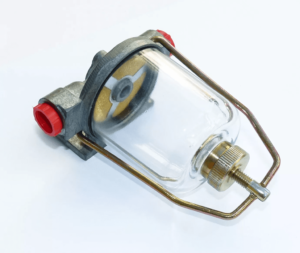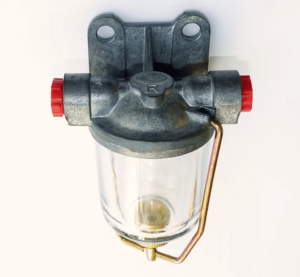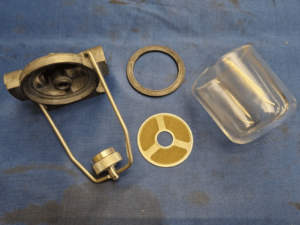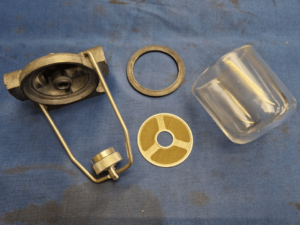In the early days of motoring, automotive engineering was marked by ingenuity and practical design aimed at solving real-world problems. One such solution was the Fuel & Water Trap Glass Bowl Filter, a simple yet highly effective component that played a crucial role in the reliability of early cars. This article delves into the history, usage, and legacy of this iconic filter, which remains beloved by vintage car enthusiasts today.
The Origins of the Fuel & Water Trap Glass Bowl Filter

As automobiles gained popularity in the early to mid-20th century, one significant challenge quickly became apparent: maintaining a clean and uninterrupted fuel supply. Roads were dusty, and fuel quality varied significantly, especially in rural areas where gasoline might contain impurities such as water, dirt, and rust particles.
To combat these issues, automotive engineers introduced the Fuel & Water Trap Glass Bowl Filter. This innovative device featured a transparent glass bowl that allowed drivers to visually inspect the fuel for contaminants. The filter’s primary function was to trap debris and separate water from gasoline before it reached the engine. By doing so, it ensured that vehicles ran smoothly, reducing the risk of engine damage caused by impure fuel.
The Role of the Glass Bowl Filter in Early Automotive Engineering
In the early days of cars, carbureted engines dominated the market. Unlike today’s modern fuel injection systems, these carbureted engines were highly sensitive to the quality of fuel they received. Even a small amount of debris could clog fuel lines or block carburetor jets, leading to poor performance or even engine failure.
The Fuel & Water Trap Glass Bowl Filter addressed these challenges by acting as both a filtration device and an early diagnostic tool. The transparent glass bowl allowed drivers and mechanics to easily see when water or debris had accumulated. With a simple twist of the drain valve at the bottom of the filter, they could remove the impurities, ensuring clean fuel continued to flow to the engine. This made the glass bowl filter not only a protective measure but also a handy maintenance tool for car owners who often took a hands-on approach to vehicle upkeep.
How the Glass Bowl Filter Worked
At its core, the Fuel & Water Trap Glass Bowl Filter performed a straightforward yet essential function: it separated impurities from gasoline. The fuel entered the filter, where gravity helped settle heavier particles, like dirt and water, at the bottom of the glass bowl. Meanwhile, the cleaner fuel flowed upward through a filter element and on to the carburetor or fuel injectors.
Drivers could inspect the glass bowl at any time to check for accumulated contaminants. If water or debris was visible, it was a clear sign that the bowl needed to be drained. This process was incredibly simple and effective: with a quick turn of a valve, the impurities were flushed out, and the fuel system was ready to go. For cars of the time, this simple maintenance task could make the difference between a smooth drive and a breakdown on the side of the road.
The Importance of Fuel Filters in Early Vehicles
During the early 20th century, fuel quality control was inconsistent, especially in rural or developing areas where gas stations were less regulated. Water contamination was a common issue, either from poor storage conditions or condensation in fuel tanks. Solid impurities such as rust, dirt, and even small metal shavings were also a constant threat to a vehicle’s performance.

The Fuel & Water Trap Glass Bowl Filter became a vital component of the automotive fuel system, ensuring that impurities didn’t make their way into the engine. This was particularly important in carbureted engines, which lacked the sophisticated sensors and monitoring systems found in modern vehicles. A clogged or contaminated fuel system could lead to stalling, poor fuel efficiency, or even engine damage, making the glass bowl filter an essential tool for keeping early cars running reliably.
Legacy of the Vintage Fuel & Water Trap Glass Bowl Filter
Although modern vehicles now use advanced fuel filters and electronic sensors to monitor fuel quality, the legacy of the Fuel & Water Trap Glass Bowl Filter lives on. For many vintage car enthusiasts, this iconic piece of equipment is more than just a functional part—it’s a symbol of a bygone era of automotive engineering, where simplicity and practicality reigned supreme.
Collectors and restorers of classic cars often seek out original glass bowl filters to maintain the authenticity of their vehicles. These filters not only add a touch of historical accuracy but also allow car owners to engage with their vehicles in a more tactile way. The clear glass bowl provides a visual link between driver and engine, allowing them to see, quite literally, how clean their fuel is.
The Appeal to Vintage Car Enthusiasts

What makes the Fuel & Water Trap Glass Bowl Filter so appealing to vintage car collectors is its blend of functionality and aesthetics. The filter’s clear design allowed for easy monitoring of fuel quality, while the simplicity of its construction made it easy to maintain. Unlike the sealed, hidden fuel filters of today’s cars, the glass bowl filter gave drivers a direct view of their engine’s lifeblood: clean fuel.
For vintage car lovers, this hands-on approach to maintenance is part of the charm. Maintaining a classic car requires dedication, and the glass bowl filter serves as a reminder of a time when drivers had to be more in tune with their vehicles. It represents an era when cars weren’t just machines but companions on the road, requiring care and attention to keep them running smoothly.
The Continued Influence on Modern Automotive Design
While the Fuel & Water Trap Glass Bowl Filter may be considered a relic by some, its influence can still be seen in modern automotive design. Today’s advanced fuel filters and water separators owe a debt to this early invention. The idea of visually inspecting fuel quality, separating water and debris, and ensuring a clean fuel supply has remained a critical element of automotive engineering.

Though modern fuel systems are more complex and less prone to contamination, the basic principles of fuel filtration remain unchanged. The Fuel & Water Trap Glass Bowl Filter paved the way for these innovations, and its legacy continues in the reliable, efficient fuel systems of today’s vehicles.
Conclusion
The Fuel & Water Trap Glass Bowl Filter stands as an enduring symbol of early automotive ingenuity. From its inception in the early 20th century to its continued use in vintage car restoration today, this simple yet effective device helped shape the evolution of fuel filtration systems. Whether you’re a collector or simply appreciate the history of automotive engineering, the glass bowl filter serves as a reminder of a time when drivers took a more hands-on approach to keeping their cars on the road. Its impact on the world of cars is undeniable, making it a key piece of automotive history.